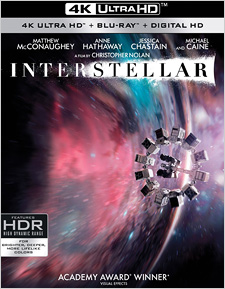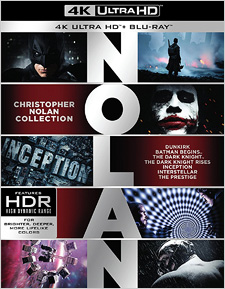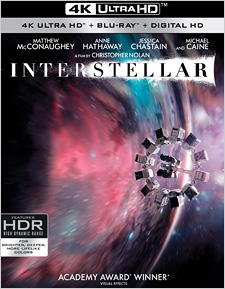Interstellar (4K UHD Review)

Director
Christopher NolanRelease Date(s)
2014 (December 19, 2017)Studio(s)
Legendary/Syncopy (Paramount)- Film/Program Grade: B
- Video Grade: A
- Audio Grade: B+
- Extras Grade: B
Review
Christopher Nolan’s Interstellar would be impressive in the ranks of contemporary hard science fiction films, even if for no other reasons than that there are so few of them these days and that its ambition is nearly unsurpassed.
The film opens fifty-some odd years from now, on an Earth in decline. Humanity’s technological achievements have faded, the global climate has become a dust bowl, and disease is wiping out so many crops that feeding everyone has become a losing effort. In these difficult circumstances, we’re introduced to Cooper (Matthew McConaughey), a former NASA engineer and pilot who’s scratching out a meager living as a farmer. He’s also struggling to raise his two young children, even as he knows that their future is bleak. But when his daughter Murphy (Mackenzie Foy) claims that her bedroom is haunted one day, Cooper investigates and uncovers a mysterious message – binary coordinates that lead him to a hidden NASA base. There he meets a former colleague, Dr. Brand (Michael Caine), who has been working for years with a team of scientists on a secret project. It seems that a stable wormhole was discovered decades earlier near Saturn. As such things can’t happen naturally, the belief is that an alien intelligence placed it there deliberately to give Humanity a chance for salvation. Brand and his team have identified three candidate worlds that might support life orbiting a supermassive black hole on the other side of the wormhole. So Brand recruits Cooper to lead a last-ditch expedition to see if one of these worlds can become Humanity’s new home. A trio of scientists will accompany Cooper on the mission, including Brand’s daughter Amelia (Anne Hathaway), along with a pair of robots. But successful or not, the mission will take years… and Cooper will have to leave his children behind.
I must admit that Interstellar is a film I’ve only come to appreciate with time. When I first saw it in the theater (projected in 70 mm film at the Cinerama Dome in Hollywood), the sound quality was terrible. It was so distorted, in fact, that a significant portion of the dialogue was simply unintelligible. I found the problem off-putting enough that I actually finished the screening with a headache. According to a statement on the film’s website, this effect was deliberate: “The sound on Interstellar has been specially mixed to maximize the power of the low end frequencies in the main channels as well as in the subwoofer channel.” Deliberate or not, many expert and savvy filmgoers were likewise frustrated and complained loudly about the sound online. After all, the whole point of going to see a large-format film in a premium theater is to achieve complete immersion in the experience. Anything that pulls you out of that experience is an irritation. At any rate, I had no interest in seeing Interstellar again theatrically, preferring instead to wait for Blu-ray. But, having seen the film again on Blu-ray and now 4K, I’ve come to appreciate that there’s a lot of good here.
For one thing, much (though not all) of the science depicted in Interstellar is incredibly accurate. Astrophysicist Kip Thorne worked closely with writer Jonathan Nolan and director Christopher Nolan to ensure a certain adherence to realism. This extends to the most accurate CG visualizations of wormholes and black holes ever presented on film. The time dilation effects experienced by Cooper and his crew are true to the rules of Einsteinian physics. The look of the film’s spacecraft, space suits, and other equipment is completely believable. Interstellar is certainly high-concept, yet it works hard to keep the focus on its characters – to contrast human-scale experience and imagery with the cosmic. All of these things are impressive.
On the other hand, Interstellar has many irrational elements as well – moments of “magical” thinking – and it’s the often awkward juxtaposition of the two that’s frustrating. For example, why send a mission through a wormhole from Earth to colonize a barely-habitable planet orbiting a black hole, when Mars is right next door? Given that the crew knows time-dilation is going to be a problem there, and that time is critical back on Earth, why not send a probe down to check out Miller’s planet first? Why would you have hibernation pods filled with liquid (like bathtubs) on a spaceship that sometimes operates in microgravity? Why doesn’t the radiation from the wormhole and the black hole’s accretion disc fry the astronauts before they ever get close? I appreciate that films need to be entertaining first, and that some suspension of disbelief is always required, but the filmmakers go to such lengths to get some of these details right that their oversights are glaring. The best examples of science fiction filmmaking – especially hard sci-fi – manage to clear both hurdles.
Yet, for all its flaws, the film succeeds as an entertainment. It beautifully captures the sense of awe inherent in the human experience of spaceflight. Some of the performances are wonderful, particularly Jessica Chastain (as the adult Murphy). McConaughey, Hathaway, and Caine are all good too. The film’s visuals and cinematography, much of it captured using handheld IMAX cameras and enhanced with background projection and interactive lighting effects, are extraordinary. Most of the spacecraft exteriors were shot old school, using large-scale miniatures, à la Alien or 2001: A Space Odyssey. Better still, life-size versions of some of these spacecraft were constructed for use in exterior landscape shoots. When Christopher Nolan discovered that these could be mounted onto the production’s massive soundstage gimbals, he bolted IMAX cameras onto them like GoPros and shot VFX footage with them maneuvering like models, capturing an extraordinary level of detail and realism in the process.
Interstellar was shot on 35 mm (anamorphic) and 65 mm (IMAX) photochemical film by cinematographer Hoyte van Hoytema (Dunkirk, Oppenheimer) using Beaumont VistaVision, Panavision Panaflex Millennium XL2, and IMAX MSM 9802 cameras with Leica, Hasselblad, Mamiya, and Panavision C-, D-, E-Series and Ultra Speed Golden lenses. Some VistaVision photography was also employed for visual effects shots. It was finished in a traditional photochemical/analog editing process, with the result being a physical master interpositive element. About 64 minutes of the film is presented in IMAX format framed at 1.43:1, with the rest in 35 mm at 2.39:1. The film was then shown theatrically in a variable aspect ratio in IMAX theaters and straight 2.39 for wide release. For Ultra HD, Nolan chose to scan the color-timed master interpositive element (and not the original camera negative) in 4K. This image was additionally graded for high dynamic range (in HDR10 only). Note that the 4K UHD presentation preserves the variable aspect ratio presentation by shifting between 2.39:1 and 1.78:1 (for the IMAX footage). It’s also been encoded on a 100GB disc to ensure maximum data rates.
The previous Blu-ray was already very good looking in 1080p HD, but the full 2160p 4K image bests it by a wide margin. For one thing, this is a film where contrast is absolutely critical in capturing the realism of outer space. Thanks to high dynamic range, the blacks have never been deeper (though they do still appear a tad gray, due to the master interpositive source), while the brightest area of the image are truly bright. In terms of detail, the 35 mm footage appears a tad soft (again due to the interpositive source, as well as additional anamorphic softness around the edges of the frame), while the 65 mm footage reveals an almost jarring level of detail. This is apparent in everything from the tiniest rivets on spacecraft to fabric and skin textures, the subtle clouds of Earth, and even the piles of dust visible on Cooper’s farm. Photochemical grain in the 35 mm footage also has a more velvety quality (again, per the source), which blends well with the IMAX footage. What’s more, the HDR-enhanced colors exhibit vividness and nuance that’s simply stunning. You see this in the Earth from orbit, the clouds of Saturn, the rippling “surfaces” of the wormhole and the bulk as Endurance passes through it, the accretion disk of Gargantua, the icy surface of Mann’s planet, and countless other details in almost every frame. The color palette of this film has always been very earthy and gray, except when it’s not. But the HDR lends this image a lovely degree of naturalism and immersion that you really have to see to fully appreciate.
From an audio standpoint, the 4K Ultra HD disc includes the exact same English 5.1 DTS-HD Master Audio track that was found on the previous Blu-ray. The mix revels in its contrasts, with incredible dynamic range that flexes between moments of silent majesty and bombastic organ chords that feature rumbling low tones you can almost feel. The mix is still strongly pushed towards the low end and it does seem to be a deliberate artistic choice. But whether it constitutes an actual fix from the grating theatrical mix or not, the upshot is that the film’s dialogue is in noticeably better balance with the music and effects here than it was in theaters. Hans Zimmer’s score will certainly not appeal to everyone, but it works well against the film’s stark and dramatic imagery, even more so now that the dialogue is actually intelligible. Additional audio options include 5.1 Dolby Digital in French and Spanish, and English 5.1 Descriptive Audio, with subtitles available in English, English SDH, French, and Spanish (again, the same offerings as the regular Blu-ray).
In addition to the 4K disc itself (which contains no extras), the packaging also includes the previous 2-disc Blu-ray special edition, which has the movie on one disc and bonus features on the other, all in 1080p HD. Those features are unusually good, particularly by the standards of more recent Blu-ray releases. The experience begins with The Science of Interstellar TV special (50:20), which is narrated by McConaughy (some of you may have seen it on the Science Channel). It touches upon the different concepts that are relevant to the film, and includes interviews with Christopher and Jonathan Nolan, astrophysicists Kip Thorne, Sean Carroll, Natalie Batalha, and Jamie Bock, astronomers Andrea Ghez and Fiona Harrison, NASA astronaut Marsha Ivans, and even Elon Musk of SpaceX fame. The science is entry-level and easy to digest, even if a bit of it is already out of date (the primordial gravity wave detection mentioned in the special has not, in fact, withstood further analysis, though gravity waves were subsequently discovered by a different experiment). Still, the special serves as a good primer and provides nice context for viewers of the film.
Next up is the 14-part Inside Interstellar documentary, which offers 122 minutes worth of behind-the-scenes material on the film’s production. There’s no “play all” option – you simply select each individual featurette from the disc’s menus. Segments include: Plotting an Interstellar Journey (7:49), Life on Cooper’s Farm (9:43), The Dust (2:38), Tars and Case (9:27), The Cosmic Sounds of Interstellar (13:40), The Space Suits(4:31), The Endurance (9:24), Shooting in Iceland: Miller’s Planet/Mann’s Planet (12:42), The Ranger and the Lander (12:20), Miniatures in Space (5:29), The Simulation of Zero-G (5:31), Celestial Landmarks(13:22), Across All Dimensions and Time (9:02), and Final Thoughts (6:02). Among the highlights are abundant material on the filmmakers’ approach to the production, good looks at the conceptual design and construction of the film’s various spacecraft and equipment, discussion of the film’s groundbreaking depictions of astrophysical phenomena, and lots of on-set interviews and footage with the cast and crew shot during filming. You even get to spend time with Zimmer as he carefully crafts his score, then records it in the midst of an English cathedral.
 Once you’ve exhausted the documentary material, you can also view the film’s teaser trailer and all three theatrical trailers. The only thing that’s really missing here is an audio commentary. I know that Christopher Nolan doesn’t do them, but a writer’s track with Jonathan and Kip Thorne, discussing the film’s ideas and the evolution of its story, would have been welcome indeed. Nevertheless, the bonus material you do get is both substantial and enjoyable. Note that the single film SKU of this 4K Ultra HD title also includes a Digital Copy code on a paper insert, but if you purchase the Christopher Nolan Collection in 4K, no Digital Copy is included – just the films in both 4K and BD with BD extras.
Once you’ve exhausted the documentary material, you can also view the film’s teaser trailer and all three theatrical trailers. The only thing that’s really missing here is an audio commentary. I know that Christopher Nolan doesn’t do them, but a writer’s track with Jonathan and Kip Thorne, discussing the film’s ideas and the evolution of its story, would have been welcome indeed. Nevertheless, the bonus material you do get is both substantial and enjoyable. Note that the single film SKU of this 4K Ultra HD title also includes a Digital Copy code on a paper insert, but if you purchase the Christopher Nolan Collection in 4K, no Digital Copy is included – just the films in both 4K and BD with BD extras.
Ultimately, Interstellar is a good science fiction film. Is it great? No, I wouldn’t go that far, though I would suggest that it’s arguably the most ambitious example of the genre to appear in theaters since the Wachowskis’ Matrix films. Simply put, Interstellar goes for it and gets a great deal right in the attempt. If it ultimately falls short of its goal, dipping a bit too far into pseudoscience and “Love Conquers All” clichés… well, so be it. Films that work this hard to be daring are a rare thing in today’s Hollywood and should be appreciated in spite of their flaws. It certainly helps that Interstellar has never looked and sounded better than it does here in 4K Ultra HD. Whether you purchase it alone or in Warner’s Christopher Nolan Collection 4K box set, it’s very definitely recommended.
- Bill Hunt
(You can follow Bill on social media at these links: Twitter and Facebook)

